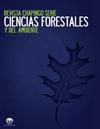提取条件对墨西哥牛至残渣中酚类化合物浓度的影响
IF 0.6
4区 农林科学
Q3 Agricultural and Biological Sciences
Revista Chapingo Serie Ciencias Forestales Y Del Ambiente
Pub Date : 2021-01-01
DOI:10.5154/r.rchscfa.2020.10.066
引用次数: 0
摘要
简介:墨西哥牛至叶(Lippia graveolens Kunth)被销售用于食品和精油提取。在适当的提取条件下,可从残叶(无油叶和茎)中获得具有抗氧化性能的酚类化合物。目的:考察提取溶剂和质量体积比对牛至叶渣中酚类化合物浓度及抗氧化能力的影响。材料与方法:以牛至叶残(不含油脂)和牛至茎为原料,分别用30%、50%和80%的乙醇水溶液(ET30、ET50、ET80)和溶剂质量体积比(1:10、1:20、1:30)提取提取物。对提取物的固体收率、总酚浓度、总黄酮浓度和抗氧化能力进行了评价。采用HPLC-DAD对各提取物进行相似性分析,UPLC-MS对主要酚类进行鉴定。结果与讨论:叶提取物得率、酚含量、总黄酮含量及抗氧化能力均高于茎。当ET80和1:30的比例时,酚类物质的浓度最大,表明其在乙醇中的溶解效果优于在水中的溶解效果。ET50和ET80提取物的酚类成分在色谱上具有相似性;柚皮素、杉木素、叶黄醇、咖啡酸和木犀草素是主要化合物。结论:从牛至无油叶和茎中提取具有抗氧化活性的类黄酮和非类黄酮酚类化合物,乙醇-水浓度和质量/溶剂比适宜。本文章由计算机程序翻译,如有差异,请以英文原文为准。
Effect of extraction conditions on the concentration of phenolic compounds in Mexican oregano (Lippia graveolens Kunth) residues
Introduction: Mexican oregano (Lippia graveolens Kunth) leaves are marketed for use in food and for essential oil extraction. Phenolic compounds with antioxidant properties can be obtained from the residues (leaves without oil and stems) under appropriate extraction conditions. Objective: To evaluate the effect of extraction solvent and mass/volume ratio on phenolic compounds concentration and their antioxidant capacity in oregano residues. Materials and methods: Residual leaf (without oil) and stems of oregano were used to obtain extracts with 30, 50 and 80 % aqueous ethanol (ET30, ET50, ET80, respectively) and solvent mass/ volume ratios (1:10, 1:20 and 1:30). Yield in solids, total phenols concentration and flavonoids, and antioxidant capacity were evaluated in the extracts. Similarity analysis between extracts was performed by HPLC-DAD and the main phenols were identified by UPLC-MS. Results and discussion: Extract yields, phenol concentrations and flavonoids and antioxidant capacity for leaves were higher than for stems. The maximum concentration of phenols was obtained with ET80 and 1:30 ratio, which indicates better dissolution in ethanol than in water. The extracts ET50 and ET80 had chromatographic similarity of phenols in both residues; naringenin, taxifolin, eriodictyol, caffeic acid and luteolin were the major compounds. Conclusion: Ethanol-water concentrations and mass/solvent ratios are feasible for obtaining flavonoid and non-flavonoid phenolic compounds with antioxidant capacity from oil-free leaves and stems of oregano.
求助全文
通过发布文献求助,成功后即可免费获取论文全文。
去求助
来源期刊
CiteScore
1.20
自引率
16.70%
发文量
0
审稿时长
>12 weeks
期刊介绍:
The Revista Chapingo Serie Ciencias Forestales y del Ambiente (RCHSCFA) is a scientific journal that aims to raise awareness of high-quality research products related to forest, arid, temperate and tropical environments in the world. Since its foundation in 1994, the RCHSCFA has served as a space for scientific dissemination and discussion at a national and international level among academics, researchers, undergraduate and graduate students, forest managers and public/private entities that are interested in the forest environment.
All content published in the journal first goes through a strict triple-blind review process and is published in the following formats: Scientific Articles, Review Articles, Methodologies, Technical or Technological Notes.

 求助内容:
求助内容: 应助结果提醒方式:
应助结果提醒方式:


